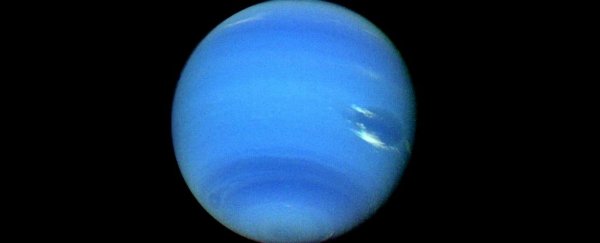Scientists have found evidence that the cores of our Solar System's smaller gas giants might be filled with 'exotic' molecular compounds, and they appear to only stick around under immense pressure.
Among the compounds that are likely to exist inside Neptune, Uranus, and Jupiter's icy moon, Europa, were carbonic acid (H2CO3) and an extremely rare compound of molecular hydrogen and methane (2CH4:3H2).
"The smaller gas giants - Uranus and Neptune - consist largely of carbon, hydrogen, and oxygen," said one of the team, Artem Oganov, from the Moscow Institute of Physics and Technology in Russia.
"We have found that at a pressure of several million atmospheres, unexpected compounds should form in their interiors. The cores of these planets may largely consist of these exotic materials."
To find the compounds, the team used a powerful algorithm called the Universal Structure Predictor: Evolutionary Xtallography (USPEX), which can predict how compounds and crystals will form under different pressures.
They decided to experiment with carbon-hydrogen-oxygen systems in particular, because these three elements are used to make organic matter and, therefore, are common among gas giants and other types of planets.
"This is an extremely important system, because all organic chemistry 'rests on' these three elements, and until now it had not been entirely clear how they behave under extreme pressures and temperatures," Oganov said.
"In addition, they play an essential role in the chemistry of the giant planets."
They found that at extremely high pressures, these three elements formed exceedingly rare compounds. For example, at roughly 4 gigapascals - about 40,788 kilograms per square centimetre (580,151 pounds per square inch) - methane and molecular hydrogen come together to form something called cocrystals.
Cocrystals are so rare, chemists can't even agree on a definition for them.
At about 6 gigapascals in the simulation, a type of cocrystal made from water and methane, called hydrates, were able to form.
At .95 gigapascals, carbonic acid became stable. This is a pretty big deal, because carbonic acid is highly unstable under normal conditions, requiring a vacuum and very low temperatures to exist as a pure compound at all.
"It is possible that the cores of Neptune and Uranus may contain significant amounts of a polymer of carbonic acid and orthocarbonic acid," Oganov said.
Besides finding the exotic compounds, the team took notes on how the carbon-hydrogen-oxygen systems changed all the way up to pressures of 400 gigapascals.
Doing so has allowed them to watch as the elements shifted around, forming and stabilising into different compounds, which in the end yielded about 125,000 different chemical structures for analysis.
While all of this sounds pretty crazy if you aren't well-versed in chemistry, the takeaway is that we're now on the cusp of understanding how compounds that are rare here on Earth might be commonplace inside the highly pressurised cores of giant planets.
And knowing this, scientists might be able to understand more about how these giants formed, and what happens inside of them.
Of course, until the results can be confirmed in something other than a computer simulation, we can't say for sure if the team's predictions are accurate, but with Jupiter throwing out some pretty massive surprises this week, we wouldn't put any strangeness past our planetary neighbours.
The team's work was published in Nature.
